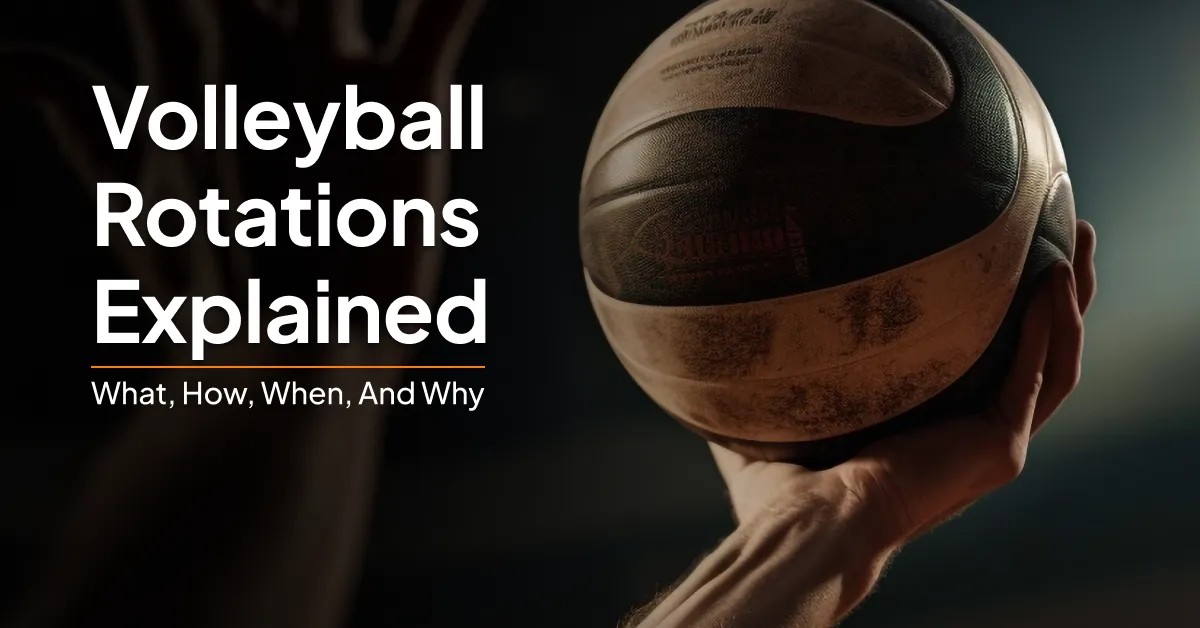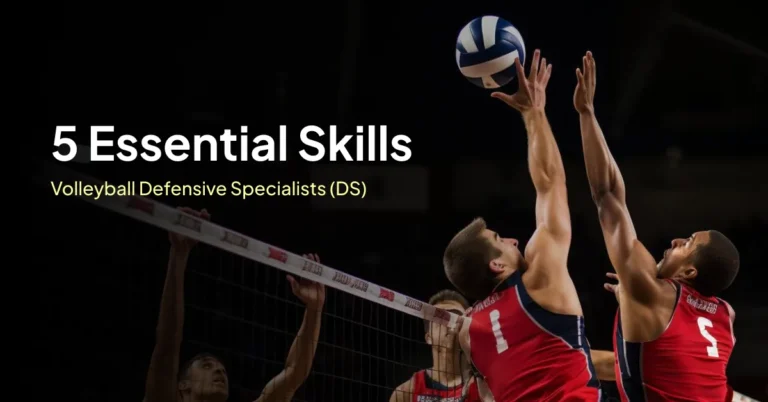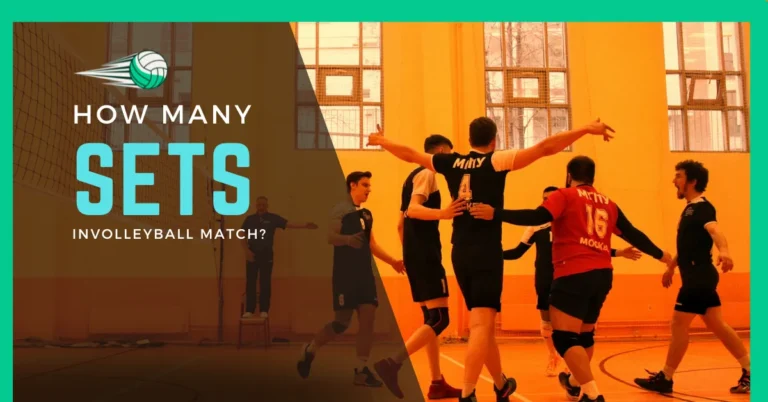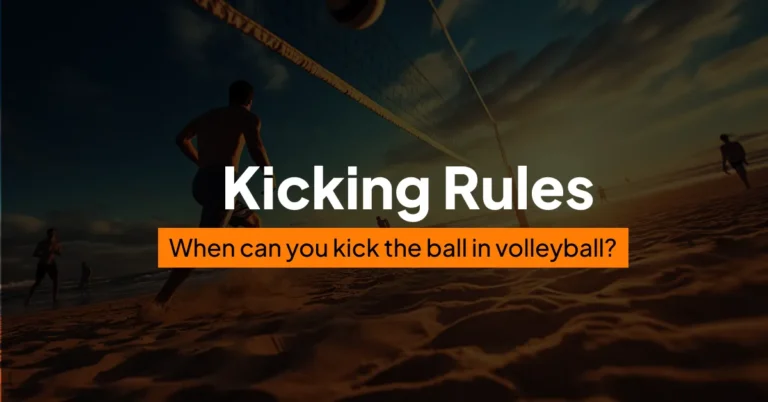Volleyball Rotations Explained: What, How, When, and Why
Volleyball is a game where players need to move around the court in a specific way. We call this movement “volleyball rotations.” These rotations happen every time a team wins the point or serve from the other team.
In this guide, we will explain how volleyball rotation works? Whether you are new to the game or want a better understanding of volleyball rotations, we will make it easy for you to know the rules and different rotation systems.
We will start by showing how players move in a clockwise direction and explaining each volleyball position from 1 to 6. Then, we will talk about the rules, like starting positions, front and back row players, and what happens if there is an error.
We will even cover different Volleyball positions and rotation systems like 4-2, 6-2, and 5-1. By the end, you will know how volleyball rotation works and why they are essential for a fair and fun game.
Do you know, How You can Easily Score a Point in Volleyball
Lets Start!
How Do Rotations Work in volleyball ?
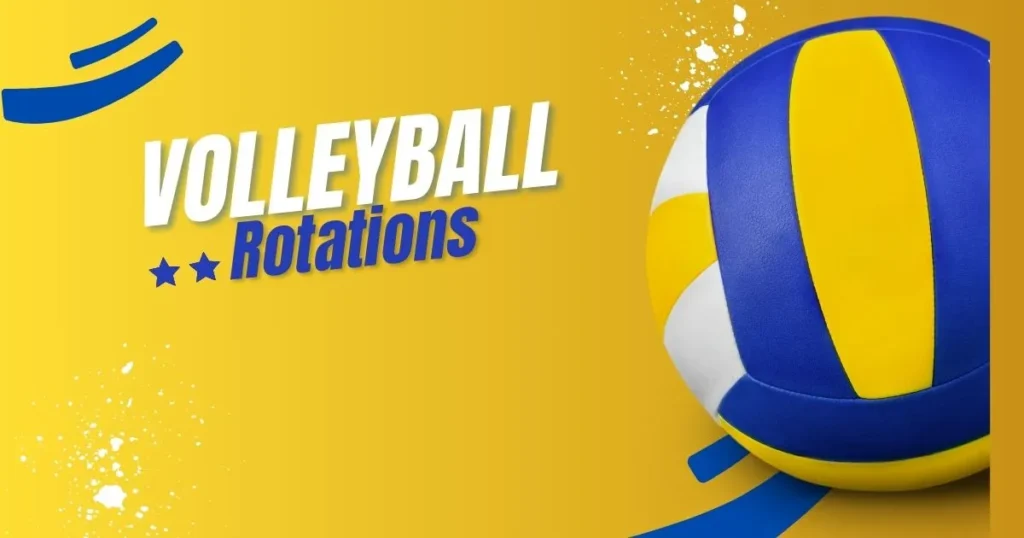
Do you know: You don’t have to stay in the same position all the time in the game. In volleyball, rotations order the positional arrangement of players on the court that changes after each side-out.
Players rotate clockwise every time they win the serve by ensuring a balanced distribution of skills and maintaining a specific alignment during both serve and receive.
Players Rotate Clockwise Every Time They Side Out
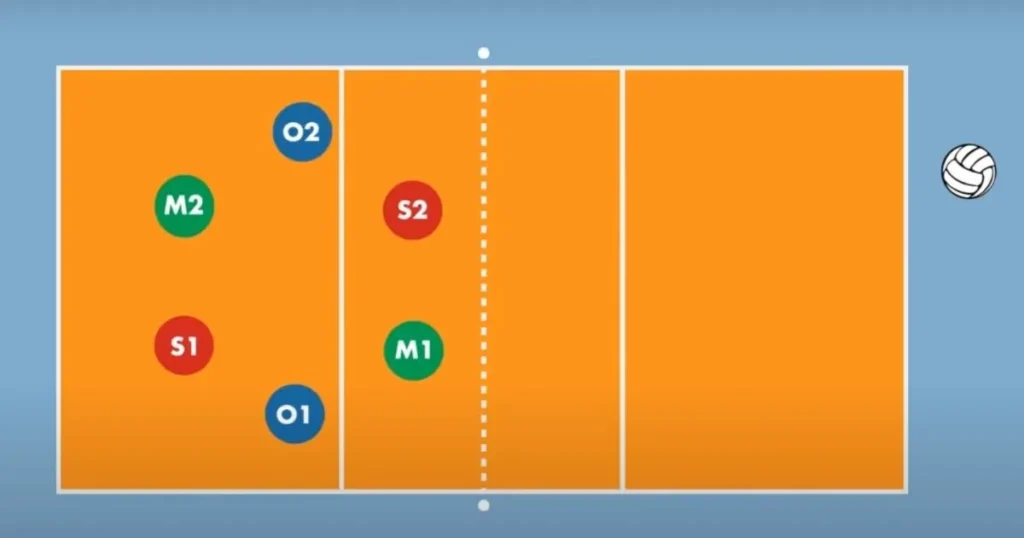
Every time a side out occurs, players rotate clockwise to assume different positions like on the volleyball court. Here is the details how player are rotated in the court.
In Position 1 (Right Back), the serving player initiates the rally with a strategic serve.
Upon serving, the player at Position-1 transitions to Position-6 (Middle Back) and prepare for defense and cover the middle of the court.
Moving in sync with the rotation, the player from Position 6 takes on Position 5 (Left Back). They help with defending and also help set up attacks.
From Position 5, the player shifts to the front row at Position 4 (Left Front). They take on offensive duties and join in blocking as well.
Following the above pattern, the player from Position 4 advances to Position 3 (Middle Front). They take on offensive responsibilities and play a key role in blocking at the net.
The rotation continues and the player in Position 3 moves to Position 2 (Right Front) to complete the cycle. At position 2, the player takes on a front-row role and is actively involved in both blocking and attacking at the net.
Volleyball Rules Of Rotation
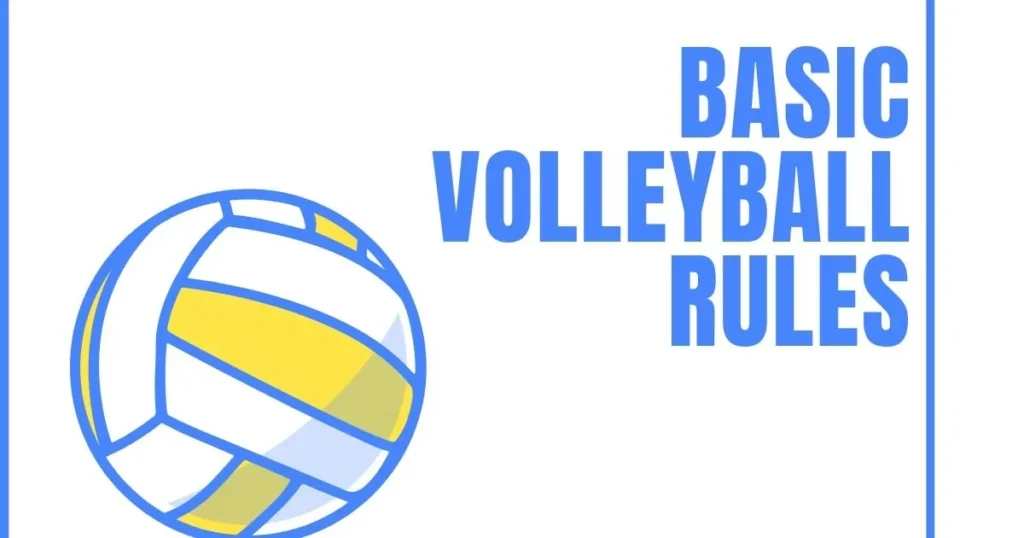
In volleyball, rotation is an important aspect of the game that ensures fair play and equal opportunities for all players. As all the players are rotated on every important position in the court, the players must have knowledge about the basic volleyball skills like Passing, digging, spiking, and serving etc.
By just looking Rotation in the game, it looks easy but it has some rules to follow. Here are the basic rules of rotation in volleyball:
- Starting Positions
- Players must start each set in a specific rotational order.
- The rotational order is determined by the starting line submitted before the match.
- Rotational Order:
- Players must rotate in a clockwise direction when viewed from above.
- Players rotate one position each time their team wins the serve from the opponent.
- Front and Back Row Players:
- Teams are divided into front row and back row players.
- The players in the front row are those who are positioned near the net, and they are allowed to attack the ball above the net height.
- Back row players are positioned at the back of the court and are not allowed to attack the ball above the net height.
- Rotation Error:
- If a player rotates out of order or fails to stand correctly during the serve, it results in a rotation error.
- Rotation errors result in the loss of the serve to the opposing team.
- Substitution Rules:
- Substitutions can only be made when it is a teams turn to serve.
- The player being substituted out must leave the court before the new player enters.
- Substituted players must enter and exit from the service area.
- Libero Player:
- The libero is a specialized defensive player who wears a different color jersey.
- The libero cannot attack the ball above the net height, block, or attempt to block.
- The libero can replace any back-row player without previous notice to the officials.
- Serving Position:
- Players must serve from behind the end line.
- Players must remain within the side lines during the serve.
- Serve Receive:
- Players must be in the correct rotational order when receiving the serve.
- After they serve, players are free to move around the court.
- Illegal Positions:
- Players must not touch the floor outside the court boundaries.
- Players must not reach over the net to block or attack the ball unless it is completely on their side.
Understanding and following these rotation rules is essential for fair play and to avoid any rotational fault in volleyball that results as penalties.
4 Different Rotations in Volleyball
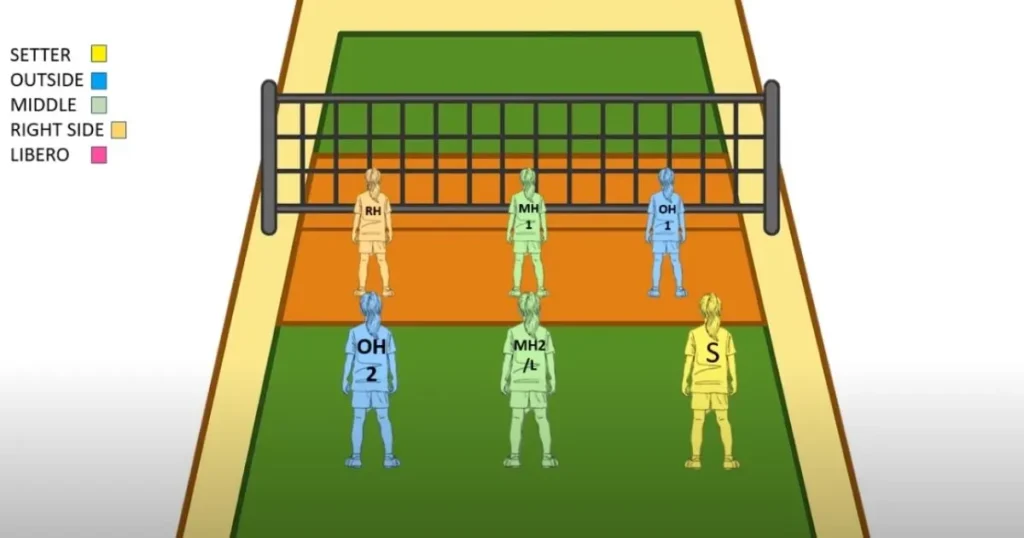
4-2 Volleyball Rotation
In this rotation, there are four hitters (attackers) and two setters on the court. The two setters are positioned opposite each other. This rotation is typically used in individual or recreational play because the 4-2 rotation simplifies play by having designated setters.
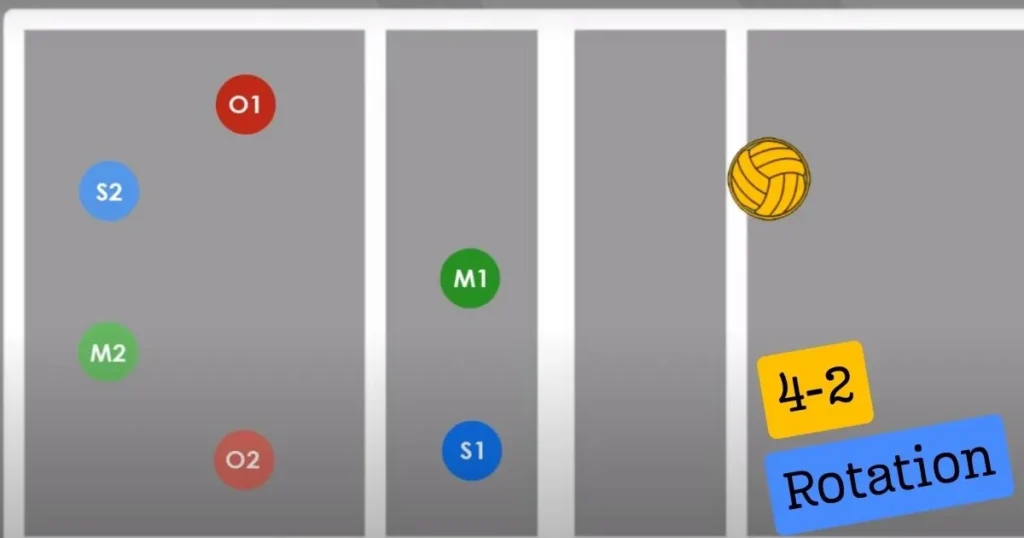
6-2 Volleyball Rotation
6-2 rotation is commonly used in higher level play. It provides multiple offensive options by having two setters who can also be hitters at the same time. In this rotation, six players are involved with two of them being designated as setters.
These two setters are positioned diagonally opposite to each other usually in the right-back and left-front positions.
Setters can also act as hitters when they are in the front row. This provides additional attacking options for the team.
5-1 Volleyball Rotation
The 5-1 rotation allows a consistent setter on the court that provides stability in playmaking. There is one denominated setter who remains in that position throughout the rotation and five other players act as both hitters and blockers. The single setter is usually a player with excellent setting skills.
The 5-1 Rotation is very common in high school level and professional play.
5-2 Volleyball Rotation
This rotation is utilized in various levels of play. Similar to the 6-2 rotation, there are five hitters and two setters (5-2 sequence). The two setters are positioned diagonally across the net from each other. It maintains five attacking options while providing flexibility in setting.
From 4 different volleyball rotations explained above, Teams have an option to choose the one that best suits their playing style and the skills of their players.
Each rotation has its own advantages and strategic considerations.
High School Volleyball Rotations: Best Options?
When it comes to high school volleyball, teams often follow a specific rotation pattern to ensure fairness, balance, and strategic play. If we compare the 6-2 volleyball rotation vs. 5-1, The most common rotation system followed in high school volleyball is the 6-2 rotation.
You can find the details about how volleyball is played as professionals in high schools
The 6-2 rotation is popular in high school volleyball because it allows for a balanced distribution of setting and attacking responsibilities. Additionally, it helps in developing players skills in both setting and hitting positions.
7 Tips To Memorize Volleyball Rotations
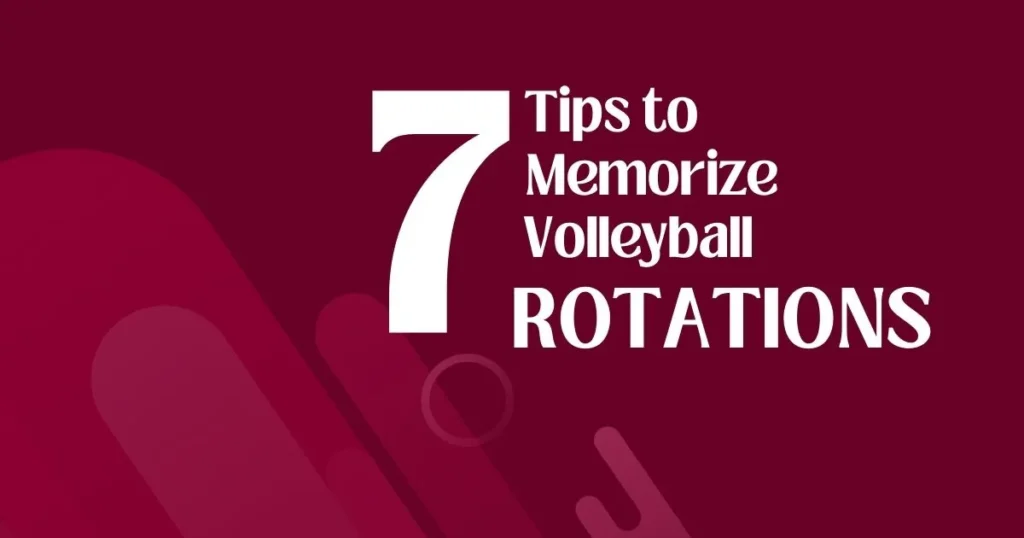
Memorizing rotations in volleyball can be challenging especially for the new players or those transitioning to more advanced levels.
Here are 7 tips that help you to memorize volleyball rotations effectively. These are:
- Create a mental image of the rotations and the positioning of players on the court because visualization can help you strengthen the order and structure of rotations in your mind.
- To make it easier to recall, you can create a phrase or form using the first letter of each rotation. This methods serve as memory aids and can simplify the memorization process.
- You can draw the volleyball court on a whiteboard or paper and physically move player markers through the rotations. This Practical approach enhances muscle memory and strengthens the sequence of positions.
- Say the order of rotations out loud as you visualize them. You can do this on your own or with your teammate.
- Engage in mutual learning by discussing rotations with your teammates, coaches, or friends. You can teach others what you know as it strengthen your understanding and information keeping.
- Make flashcards with the positions and numbers related to each rotation. Ask questions yourself or have a teammate quiz.
- Use diagrams or charts that show volleyball rotation. Having a visual aid can help understand the Positional relationships.
Volleyball Rotation FAQ

What is the easiest volleyball rotation?
The difficulty of rotations can vary among players. However, the 4-2 rotation is often considered simpler for beginners. In this setup, there are four hitters (attackers) and two setters on the court.
What happens if you are called out of rotation?
If a player is called out of rotation, it results in a rotation error. This mistake can lead to the loss of the serve to the opposing team.
Do pro volleyball players rotate?
Yes, professional volleyball players follow rotations just like players at other levels. Rotation is a fundamental aspect of the game that ensures fair play and equal opportunities for all team members.
How does a libero rotate?
The libero, a specialized defensive player, can replace any back row player without boss notice to the officials. The libero cannot attack the ball above the net height directly.
Final Words
In a nutshell, Volleyball rotations are the important movement of players on the court. Whether you are just starting or improving your playing skill, learn the basic steps of clockwise moves, starting positions, and the 6-2 rotation. Keep practicing and use memory tricks. Soon, you will play the game like a pro.

